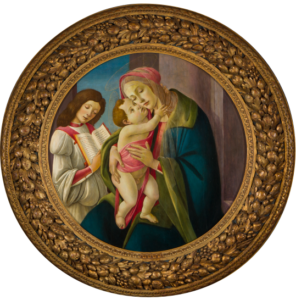Object of the Month: December 2014
Madonna and Child with an Angel (“Madonna of the Magnificat”)
Tempera on panel
Alessandro di Mariano Filipepi, called Sandro Botticelli (and studio)
Florentine, 1444/45–1510
Click on the links throughout the article to view additional artists’ works and reference material.
The Florentine master Botticelli is known for creating elegantly fluid lines that give his paintings what art experts call an “ethereal quality.” Two expressive works showcasing this skill are his Madonna and Child with an Angel (c. 1490) and his Mystic Nativity (c. 1500). Although both works highlight Christ’s incarnation, the overall composition and thematic nuances are vastly different.
This first work, a tondo from M&G’s collection, portrays a tender embrace between Mary and the Christ child. The pose of the central figures readily awakens in the viewer that universal feeling of familial love. It is an intimate human scene, but one that illuminates the wonder of the Word becoming flesh. This wonder is further explored through the angel who (unlike most angelic messengers) is without the defining attribute of wings. The angel’s focus on Mary’s Magnificat is also significant, for it draws our attention to the text that “gives voice” to the painting’s key theme: “My soul doth magnify the Lord, and my spirit hath rejoiced in God my Savior.”
The beautiful intimacy between Mary and the Christ child is also implied through the central vignette of his Mystic Nativity. However, radiating from this focal point is a sweeping panorama that takes the viewer beyond the incarnation to the final judgment. It is one of Botticelli’s most unusual works; it is also his only known signed painting. In his later years, Botticelli came under the influence of the fiery reformer Savonarola. In The Panorama of the Renaissance Margaret Aston notes that the “more expressive and powerful force discernible in his later works may represent his spiritual response to [Savonarola and] the spiritual unrest in Florence.” Aston also points out that despite the juxtaposition of the incarnation with the apocalypse, the overall tone of the painting is joy. The apocalypse, usually so terrifying, is here transformed through the angels’ celebration. Clearly, this nativity will change everything.
Donnalynn Hess, Director of Education
Published in 2014
